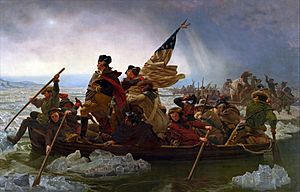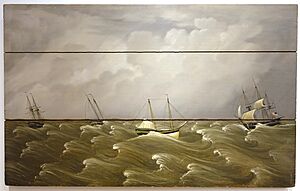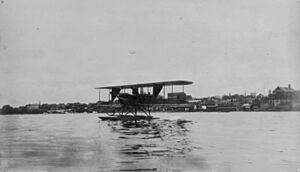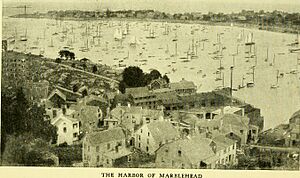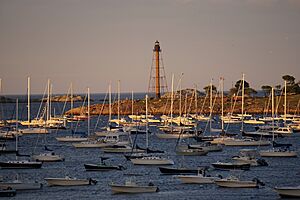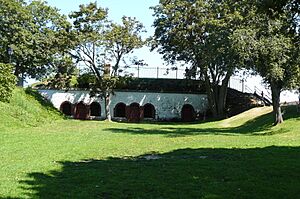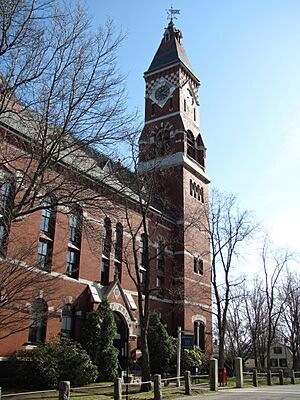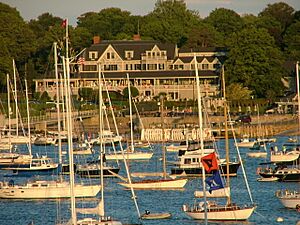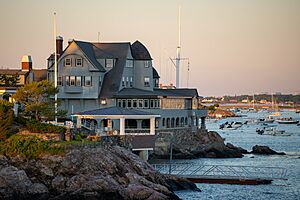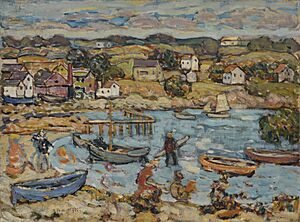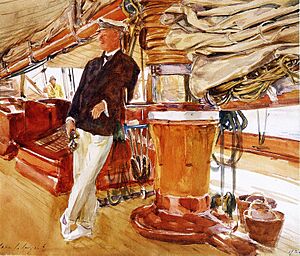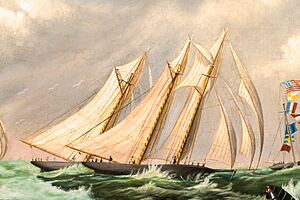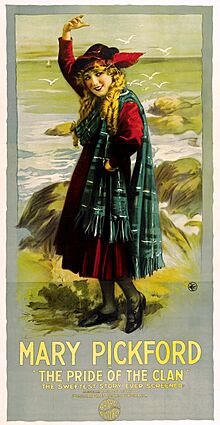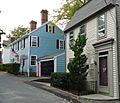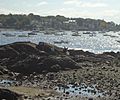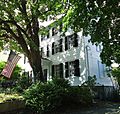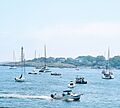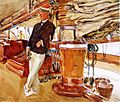Marblehead, Massachusetts facts for kids
Quick facts for kids
Marblehead, Massachusetts
|
||
|---|---|---|
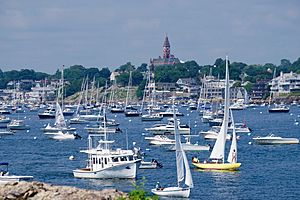
Marblehead harbor viewed from the lighthouse
|
||
|
||
| Nickname(s):
MHD
|
||
| Motto(s):
"Where History Comes Alive"
|
||
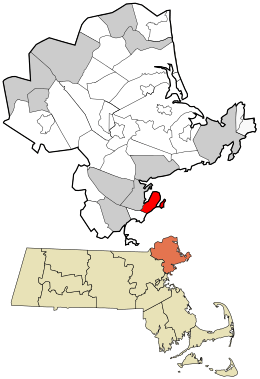
Location in Essex County and Massachusetts
|
||
| Country | United States | |
| State | Massachusetts | |
| County | Essex | |
| Settled | 1629 | |
| Incorporated | 1649 | |
| Government | ||
| • Type | Open town meeting | |
| Area | ||
| • Total | 19.58 sq mi (50.71 km2) | |
| • Land | 4.39 sq mi (11.37 km2) | |
| • Water | 15.19 sq mi (39.34 km2) | |
| Elevation | 65 ft (20 m) | |
| Population
(2020)
|
||
| • Total | 20,441 | |
| • Density | 4,656.26/sq mi (1,797.79/km2) | |
| Demonym(s) | Header | |
| Time zone | UTC−5 (Eastern) | |
| • Summer (DST) | UTC−4 (Eastern) | |
| ZIP Code |
01945
|
|
| Area code(s) | 339/781 | |
| FIPS code | 25-38400 | |
| GNIS feature ID | 0618300 | |
Marblehead is a cool coastal town in Massachusetts, located in Essex County. It sits on the North Shore of the state. In 2020, about 20,441 people lived here. The town is built on a small piece of land that sticks out into Massachusetts Bay. There's also a nearby island called Marblehead Neck, connected by a narrow strip of land. Marblehead Harbor is a safe place for boats, protected by rocks and shallow areas. Besides the main town center, Marblehead has two other areas: Old Town (the original center) and Clifton.
Marblehead has a long history with commercial fishing and yachting. It was a big shipbuilding area and is often called the "birthplace of the American Navy". It was once the top fishing spot in Massachusetts. It's also where Marine Corps Aviation began. Three U.S. Navy ships have been named USS Marblehead. Today, it's a popular spot for recreational boating, sailing, kayaking, and fishing. Many yacht clubs were started here in the late 1800s.
The town is home to the Marblehead Light, Fort Sewall, and the Marblehead Neck Wildlife Sanctuary. You can also visit Crocker Park and Devereux Beach. The famous painting The Spirit of '76 by Archibald Willard is kept at Abbot Hall. A large part of the Old Town is protected as a Marblehead Historic District. Marblehead also has the oldest adult softball league in the world, started in 1939.
Contents
A Look Back: Marblehead's History
Early Days: Massebequash and Native Americans
Long ago, Marblehead was known as Massebequash. This name came from a river between Marblehead and Salem. The land was home to the Naumkeag tribe, part of the Pawtucket confederation. Their leader was Nanepashemet. Sadly, many tribe members died from diseases in the early 1600s. Over the years, people have found old shell mounds and burial sites, showing where villages once stood. In 1684, Nanepashemet's family sold their land, which was about 3,700 acres (15 km²). The official paper for this sale is still at Abbot Hall.
European Settlers and Fishing Life
The first European settlers arrived in Marblehead around 1629. One of the first was Joseph Doliber or John Peach. A few years earlier, in 1626, Isaac Allerton, a Pilgrim from the Mayflower, started a fishing village here. In 1635, the Massachusetts Bay General Court made Marblehead a town. But less than a year later, they changed their minds. Finally, in 1649, Marblehead became its own town, separate from Salem.
The town was sometimes called "Marvell Head" or "Marble Harbour." Settlers named it "Marblehead" because they thought its granite rocks looked like marble. It started as a fishing village with narrow, winding streets. The smell of drying fish, especially cod, was common along the shore. These fish were sent to other places and to Salem.
During the Salem Witch Trials, one woman from Marblehead, Wilmot Redd, was accused. She was found guilty and sadly executed in 1692.
Marblehead's economy was strongest just before the American Revolution. Local ships, called privateers, would capture goods from large European ships. Many old buildings from this time still stand, like the Jeremiah Lee Mansion.
Marblehead in the Revolutionary War
Many Marblehead residents joined the fight early in the Revolutionary War. The sailors from Marblehead are often seen as the first members of the United States Navy. The first ship for the army, Hannah, was prepared with cannons, ropes, and food by a crew from Marblehead. These brave sailors, led by General John Glover, helped the Continental Army escape after the Battle of Long Island.
The Marblehead soldiers became the 14th Continental Regiment in George Washington's army. It was one of the few army groups that included soldiers of different backgrounds. Marblehead men also [[George Washington's crossing of the Delaware River|helped George Washington cross the Delaware River]]. This was for his surprise attack on Trenton. Many soldiers did not return from the war. This left the town with many widows and orphaned children.
The town lost many people and its economy suffered. Still, it was the tenth-largest place in the United States in 1790. When George Washington visited in 1789, he knew the Marblehead sailors well. He said the town "had the appearance of antiquity."
The Fishing Industry and its Challenges
For 75 years after the American Revolution, Marblehead had a great time with fishing. The War of 1812 caused problems, similar to the Revolution. Fishing areas were blocked, and many fishermen went to war. Over 500 Marblehead men were captured by the British. After the war, richer citizens wanted a new bank to help fishermen and merchants. So, in 1831, they started the Grand Bank.
In 1837, the town's fishermen had 98 vessels. They often caught fish off the Grand Banks of Newfoundland. But a big storm in 1846 sank 11 ships and damaged others. With 65 men and boys lost, the town's fishing industry started to decline. A painting by William Thompson Bartoll shows this storm.
Marblehead in the Civil War
During the Civil War, 1,048 men from Marblehead joined the Army and Navy. One hundred ten died, and 87 were wounded. Many later died from their injuries. Marblehead raised almost $100,000 to help the war effort. This was a huge amount for a town of 8,000 people who mainly relied on fishing. Marblehead was the first town in Massachusetts to send troops. After the war, a veterans group was formed. They set up their headquarters in the old town house, where they still show items from the Marblehead regiments.
Shoemaking, Airplanes, and Yachting
In the late 1800s, Marblehead had a short period of growth from shoe-making factories. At the same time, the amazing harbor attracted wealthy boat owners. Many yacht clubs were started here. These included the Boston Yacht Club, Corinthian Yacht Club, and the Pleon Yacht Club, which is the oldest junior yacht club in America. Rich people from Boston also built many "summer homes" on Marblehead Neck. This building boom caused the Marblehead Light to be replaced in 1896. The old, shorter tower's light was being blocked by the new, large homes.
Marblehead was also home to the Burgess & Curtis Aircraft Factory. This was the first licensed aircraft manufacturer in the United States. William Starling Burgess designed and tested most of the planes made there. On August 20, 1912, Alfred Austell Cunningham became the first Marine aviator. He took off from Marblehead Harbor in a seaplane given to him by the Burgess Company. His flight marked the start of United States Marine Corps Aviation.
Modern Marblehead: A Community by the Sea
After World War II, the town's population grew a lot. It became a place where people lived and commuted to jobs in nearby Boston, Lynn, and Salem. This growth slowed down around 1970. Today, Marblehead is still a popular place for sailing and tourism in the summer.
Geography and Getting Around
Marblehead is made up of about 4.4 square miles (11.4 km²) of land and 15.2 square miles (39.4 km²) of water. This means about 77.61% of the town's area is water!
Marblehead is on the North Shore of Massachusetts. It sits along Massachusetts Bay and Salem Harbor. The town is on a rocky piece of land that goes out into the bay. There's also a "neck" of land to the east, connected by a long sandbar that is now a road. This land creates Marblehead's deep, safe harbor. Marblehead Neck has a bird sanctuary, Castle Rock, and Chandler Hovey Park. The Marblehead Light is at the northern tip of the Neck.
Fountain Park and Fort Sewall are at the western entrance of Marblehead Harbor. The town also includes small islands in Massachusetts Bay. There are four beaches and six yacht clubs. You can also find a public kayaking center and boat ramps.
Besides Marblehead Neck, there are two other areas in town: Old Town and Clifton. Because the land area is small, most homes are built close together. Marblehead's town center is about 4 miles (6.4 km) from Salem. It's about 16 miles (26 km) northeast of Boston and 12 miles (19 km) southwest of Cape Ann. Marblehead is next to Swampscott to the south and Salem to the northwest.
Massachusetts Route 114 and Route 129 both end in Marblehead. Route 114 goes west into Salem. Route 129 goes south into Swampscott towards Lynn. There are no major highways in town. The closest highways are in Peabody and Beverly.
Two MBTA bus routes, the 441 and 442, start in Marblehead. They offer service to Boston. On weekends, they go to Wonderland station in Revere. The old train lines that connected through Swampscott and Salem closed in the late 1950s. These tracks are now bike trails, and the old train stations were taken down. The Newburyport/Rockport Line of the MBTA Commuter Rail runs through nearby Swampscott and Salem. This train goes between the North Shore and Boston's North Station. For air travel, the closest small airport is Beverly Municipal Airport. For bigger flights, Logan International Airport in Boston is the nearest. You can also take a ferry from Salem to Boston during certain seasons.
Weather in Marblehead
Marblehead has a climate that is either a humid continental climate or an oceanic climate. This means it has warm summers and cold winters. The hottest temperature ever recorded in Marblehead was 101°F (38°C) on July 23, 2011. The coldest temperature ever was -20°F (-29°C) on February 4, 2023.
| Climate data for Marblehead, Massachusetts, 1991–2020 normals, extremes 1984–present | |||||||||||||
|---|---|---|---|---|---|---|---|---|---|---|---|---|---|
| Month | Jan | Feb | Mar | Apr | May | Jun | Jul | Aug | Sep | Oct | Nov | Dec | Year |
| Record high °F (°C) | 71 (22) |
72 (22) |
91 (33) |
94 (34) |
97 (36) |
98 (37) |
101 (38) |
97 (36) |
97 (36) |
84 (29) |
78 (26) |
77 (25) |
101 (38) |
| Mean maximum °F (°C) | 56.8 (13.8) |
56.7 (13.7) |
65.3 (18.5) |
78.3 (25.7) |
86.4 (30.2) |
90.8 (32.7) |
92.7 (33.7) |
90.5 (32.5) |
87.9 (31.1) |
77.7 (25.4) |
68.8 (20.4) |
59.6 (15.3) |
94.7 (34.8) |
| Mean daily maximum °F (°C) | 36.1 (2.3) |
37.9 (3.3) |
44.3 (6.8) |
55.1 (12.8) |
65.2 (18.4) |
74.2 (23.4) |
80.3 (26.8) |
79.0 (26.1) |
72.3 (22.4) |
61.2 (16.2) |
50.7 (10.4) |
41.6 (5.3) |
58.2 (14.5) |
| Daily mean °F (°C) | 27.0 (−2.8) |
28.7 (−1.8) |
35.3 (1.8) |
45.4 (7.4) |
55.1 (12.8) |
64.3 (17.9) |
70.5 (21.4) |
69.3 (20.7) |
62.6 (17.0) |
51.8 (11.0) |
41.8 (5.4) |
33.0 (0.6) |
48.7 (9.3) |
| Mean daily minimum °F (°C) | 17.9 (−7.8) |
19.6 (−6.9) |
26.3 (−3.2) |
35.6 (2.0) |
45.0 (7.2) |
54.4 (12.4) |
60.7 (15.9) |
59.6 (15.3) |
53.0 (11.7) |
42.3 (5.7) |
32.9 (0.5) |
24.3 (−4.3) |
39.3 (4.0) |
| Mean minimum °F (°C) | 1.5 (−16.9) |
5.6 (−14.7) |
12.1 (−11.1) |
28.4 (−2.0) |
36.8 (2.7) |
45.5 (7.5) |
55.0 (12.8) |
53.1 (11.7) |
42.5 (5.8) |
30.8 (−0.7) |
21.3 (−5.9) |
10.3 (−12.1) |
−0.7 (−18.2) |
| Record low °F (°C) | −6 (−21) |
−20 (−29) |
3 (−16) |
8 (−13) |
26 (−3) |
35 (2) |
45 (7) |
42 (6) |
33 (1) |
13 (−11) |
6 (−14) |
−8 (−22) |
−20 (−29) |
| Average precipitation inches (mm) | 3.75 (95) |
3.50 (89) |
4.71 (120) |
4.30 (109) |
3.48 (88) |
4.14 (105) |
3.48 (88) |
3.25 (83) |
3.56 (90) |
5.00 (127) |
4.15 (105) |
4.70 (119) |
48.02 (1,218) |
| Average snowfall inches (cm) | 13.3 (34) |
8.5 (22) |
7.5 (19) |
1.5 (3.8) |
0.0 (0.0) |
0.0 (0.0) |
0.0 (0.0) |
0.0 (0.0) |
0.0 (0.0) |
0.1 (0.25) |
0.8 (2.0) |
7.4 (19) |
39.1 (100.05) |
| Average precipitation days (≥ 0.01 in) | 9.7 | 8.5 | 9.5 | 10.8 | 11.2 | 9.9 | 9.0 | 8.0 | 8.3 | 10.3 | 10.0 | 10.2 | 115.4 |
| Average snowy days (≥ 0.1 in) | 4.0 | 3.6 | 2.4 | 0.4 | 0.0 | 0.0 | 0.0 | 0.0 | 0.0 | 0.1 | 0.4 | 2.1 | 13.0 |
| Source 1: NOAA | |||||||||||||
| Source 2: National Weather Service | |||||||||||||
People and Population
| Historical population | ||
|---|---|---|
| Year | Pop. | ±% |
| 1790 | 5,661 | — |
| 1800 | 5,211 | −7.9% |
| 1810 | 5,900 | +13.2% |
| 1820 | 5,630 | −4.6% |
| 1830 | 5,149 | −8.5% |
| 1840 | 5,575 | +8.3% |
| 1850 | 6,167 | +10.6% |
| 1860 | 7,646 | +24.0% |
| 1870 | 7,703 | +0.7% |
| 1880 | 7,467 | −3.1% |
| 1890 | 8,202 | +9.8% |
| 1900 | 7,582 | −7.6% |
| 1910 | 7,338 | −3.2% |
| 1920 | 7,324 | −0.2% |
| 1930 | 8,668 | +18.4% |
| 1940 | 10,856 | +25.2% |
| 1950 | 13,765 | +26.8% |
| 1960 | 18,521 | +34.6% |
| 1970 | 21,295 | +15.0% |
| 1980 | 20,126 | −5.5% |
| 1990 | 19,971 | −0.8% |
| 2000 | 20,377 | +2.0% |
| 2010 | 19,808 | −2.8% |
| 2020 | 20,441 | +3.2% |
| 2023 | 20,296 | −0.7% |
Source: United States Census records and Population Estimates Program data. |
||
In 2010, Marblehead had 19,808 people living there. There were 8,838 households and 5,467 families. The town had about 4,373 people per square mile. Most of the people (97.6%) were White. About 1.0% were Asian, and 0.4% were Black. Less than 1% were Hispanic or Latino.
About 31.2% of households had children under 18. Most households (56.5%) were married couples. The average household had 2.37 people. The average family had 2.94 people.
The population was spread out by age. About 23.9% were under 18. About 15.6% were 65 or older. The average age was 42 years old.
In 2009, the average income for a household was $97,441. For families, it was $129,968. About 4.3% of the people lived below the poverty line. This included 5.7% of those under 18.
Schools in Marblehead
Marblehead Public Schools runs several schools. These include Brown and Glover elementary schools. There's also the Village School for grades 4–6. Older students attend Marblehead Veterans Middle School and Marblehead High School.
Marblehead is also home to the Marblehead Community Charter Public School. This was the first public charter school in Massachusetts. Tower School is a private school for students from kindergarten to eighth grade.
Marblehead's Town Song
Marblehead has its own official town song called "Marblehead Forever." It's played at most big town events. Reverend Marcia Martin Selman wrote the words. The music comes from an old hymn tune.
Fun Places to Visit
- Castle Rock Park
- Crocker Park, a gift from Uriel Crocker
- Crowninshield (Brown's) Island
- Gerry Island, named after Elbridge Gerry, a founding father from Marblehead
- The Driftwood
- Herreshoff Castle
- The Landing, a public dock on Front Street
- Marblehead Historic District
- Marblehead Light, at Chandler Hovey Park
- Marblehead Neck Wildlife Sanctuary
- Pleon Yacht Club, the oldest junior yacht club in the United States
Historic Sites and Museums
- Abbot Hall (built 1877): See The Spirit of '76 painting and a Maritime Exhibit.
- Fort Sewall (built 1644)
- Old Burial Hill (started 1638)
- Marblehead Museum
- Old Town House (built 1727): Also has a Civil War Museum.
- General John Glover House
- General Glover Farm
- Jeremiah Lee Mansion (built 1768)
- King Hooper Mansion (built 1728): Now home to the Marblehead Arts Association.
- Old Powder House (built 1755)
- Ambrose Gale House (built 1663)
- Simon Bradstreet House (built 1723)
- St. Michael's Church (built 1714)
- Old North Church (built 1824)
- William L. Hammond Park: Recognized as the birthplace of Marine Corps Aviation.
- Gun House (built 1810)
Yacht Clubs for Sailors
Marblehead has six active yacht clubs:
| Name | Founded | Burgee | Notable Events | Current
Club House Occupied |
|---|---|---|---|---|
| Boston Yacht Club | 1866 |
|
1950s | |
| Eastern Yacht Club | 1870 |
|
1881 | |
| Marblehead Yacht Club | 1878 |
|
1878 | |
| Corinthian Yacht Club | 1885 |
|
1885 | |
| Pleon Yacht Club
(under 21 only) |
1887 |
|
2010s | |
| Dolphin Yacht Club | 1950 |
|
1955 |
Famous People from Marblehead
Leaders and Military Heroes
- Nicholson Broughton: First Captain of the American Navy.
- Elbridge Gerry: Fifth Vice President of the United States.
- John Glover: A general in the Revolutionary War.
- John Manley: A Commodore in the American Navy.
- David D. McKiernan: A retired four-star general in the United States Army.
- Seth Moulton: A retired Marine Corps officer and current Congressman.
- Joseph Story: A Supreme Court justice.
Athletes and Sports Stars
- Shalane Flanagan: Olympic runner, Silver medalist in 2008, and 2017 New York Marathon winner.
- Tyler Hamilton: Cyclist.
- Kayla Harrison: Mixed martial artist and Olympic gold medalist in Judo (2012, 2016).
- Ted Hood: Famous yachtsman and America's Cup winner.
- Shawn McEachern: Stanley Cup winner.
- Maureen McKinnon-Tucker: Gold Medalist in Sailing at the 2008 Summer Paralympics.
- Cory Schneider: Goaltender for the New Jersey Devils.
Artists and Entertainers
- Frank Black: Musician, part of the band Pixies.
- Rob Delaney: Comedian.
- Loyd Grossman: UK television host.
- Estelle Parsons: Actress, won an Academy Award for Bonnie and Clyde (1967).
- Jamie Walters: Actor and musician, known from 90210.
Famous Visitors to Marblehead
Presidents and Important Figures
- President George Washington: Visited in 1789 as part of his tour of Massachusetts.
- Marquis de Lafayette: Visited in 1784 and 1824 to honor General John Glover and see his friend Elbridge Gerry.
- President Chester Arthur: Visited in 1882.
- President Coolidge: Visited in 1925 on the presidential yacht.
- President Franklin Roosevelt: Visited in 1933 for a sailing trip.
- Prince Olav of Norway: Went sailing in Marblehead in 1939.
- Senator John F. Kennedy: Visited the "Spirit of 76" painting with his wife Jacqueline.
- Mikhail Gorbachev: Soviet leader.
Celebrities and Writers
- Lucille Ball: Arrived by helicopter in 1947 to perform in a summer theater series.
- Vivian Vance: Also performed in the summer theater series.
- Walter Cronkite: Visited in 1997 for the USS Constitution's 200th anniversary.
- Billie Burke: Actress, known as Glinda in The Wizard of Oz, performed in 1955.
- Eva Gabor: Actress, performed in the summer theater series.
- Ethel Waters: American blues singer, performed in Marblehead in 1955.
- Sarah Churchill: Actress and daughter of Winston Churchill, performed in the summer series.
- H. P. Lovecraft: Visited in 1922. He used Marblehead as the inspiration for his fictional town of Kingsport.
- Sylvia Plath: American poet and novelist, visited in 1951.
Marblehead in Arts and Media
Paintings of Marblehead

Many famous paintings show scenes and people from Marblehead. Some artists who painted Marblehead include:
- William Thompson Bartoll
- Alfred Thompson Bricher
- John Singleton Copley
- Clement Drew
- J.O.J. Frost
- James Jeffrey Grant
- Frederick Childe Hassam
- M.H. Howes
- John Ross Key
- Fitz Henry Lane
- Orlando Rouland
- Maurice Brazil Prendergast
- Arthur Quartley
- John Singer Sargent
- James David Smillie
- William R. Stone
- Mary Bradish Titcomb
- Stanley Wingate Woodward
Movies Filmed in Marblehead
Several movies have been filmed in Marblehead:
- The Pride of the Clan (1917) starring Mary Pickford
- Home Before Dark (1958)
- Coma (1978)
- The Witches of Eastwick (1986)
- The Good Son (1993)
- Hocus Pocus (1993)
- Autumn Heart (2000)
- Treading Water (2001)
- Moonlight Mile (2002)
- Grown Ups (2010)
- The Company Men (2010)
- Grown Ups 2 (2012)
- Hubie Halloween(2019)
- Godmothered (2020)
Marblehead on TV
While no TV shows have been filmed in Marblehead, the town has been mentioned in several series:
- Marblehead Manor (1987): A sitcom about a rich Marblehead resident.
- Cheers: Mentioned three times in this show set in Boston.
- Sabrina, the Teenage Witch: Aunt Hilda mentions Marblehead in one episode.
- The Crossing (2000): A TV movie where General Washington talks about Marblehead men.
- The West Wing: Marblehead is mentioned in an episode about the Daughters of the Revolution.
- The Handmaid's Tale: Marblehead is mentioned in season one.
Books About Marblehead
Many books are set in Marblehead or are inspired by it:
- Marblehead by Joan Thompson
- The Hearth & Eagle by Anya Seton
- Agnes Surriage by Edwin Lassetter Bynner
- The Fountain Inn by Nathan P. Sanborn
- The Death and Life of Charlie St. Cloud by Ben Sherwood
- General John Glover and His Marblehead Mariners by George Athan Billias
- The Wizard of Orne Hill and Other Tales of Old Marblehead by Dorothy Miles
- At the Point of Cutlass by Gregory Flemming
- Hidden Silver by Georgene Faulkner
- Azor of Marblehead Series by Maude Cowley
- Swansday at Redd's by Ray Cole
- Remembering James J. H. Gregory: The Seed King, Philanthropist, Man by Shari Kelley Worrell
- Marblehead from HollyHocks to Hot Top by John D Hill, Morrill S. Reynolds, Phyllis Masters, Percy L. Martin
- Ashton's Memorial: An History of the Strange Adventures of Philip Ashton, Jr. (1725)
- Marblehead's First Harbor: The Rich History of a Small Fishing Port by Hugh Peabody Bishop and Brenda Bishop Booma
- The Lace Reader by Brunonia Barry
- A Guide to Marblehead by Samuel Roads Jr. (1881)
- Old Marblehead by Samuel Chamberlain (1940)
- Peaches Point: The Summer World Of T.H. Shepard By Timothy Shepard (1976)
- History and Traditions of Marblehead by Samuel Roads Jr. (1880)
- In the Time of Worms: An Ancient Tale of Marblehead by Kenelm Winslow Harris
- Under the Golden Cod by 350th Anniversary book Committee
- Captains Courageous by Rudyard Kipling
- The Autobiography of Ashley Bowen (1728–1813) by Ashley Bowen
- Red On Black, A Marblehead Story by Eben Weed
- Where Away: The Story of USS Marblehead by George Sessions Perry and Mabel Leighton
- 'Ten Hours Until Dawn by Michael J. Tougias
- Marblehead: The Spirit of '76 Lives Here by Priscilla Sawyer Lord (1972)
Some books were influenced by Marblehead:
- Rabbi Small by Harry Kemelman: The fictional town of Barnard's Crossing is based on Marblehead.
- The Jesse Stone novels: The fictional town of Paradise is thought to be based on Marblehead.
- Kingsport: H. P. Lovecraft used Marblehead as a big inspiration for his fictional town.
Images for kids
-
Marblehead, watercolor, Maurice Prendergast, 1914. Museum of Fine Arts, Boston
-
Mrs Jeremiah Lee, Martha Swett, John Singleton Copley
See also
 In Spanish: Marblehead (Massachusetts) para niños
In Spanish: Marblehead (Massachusetts) para niños



